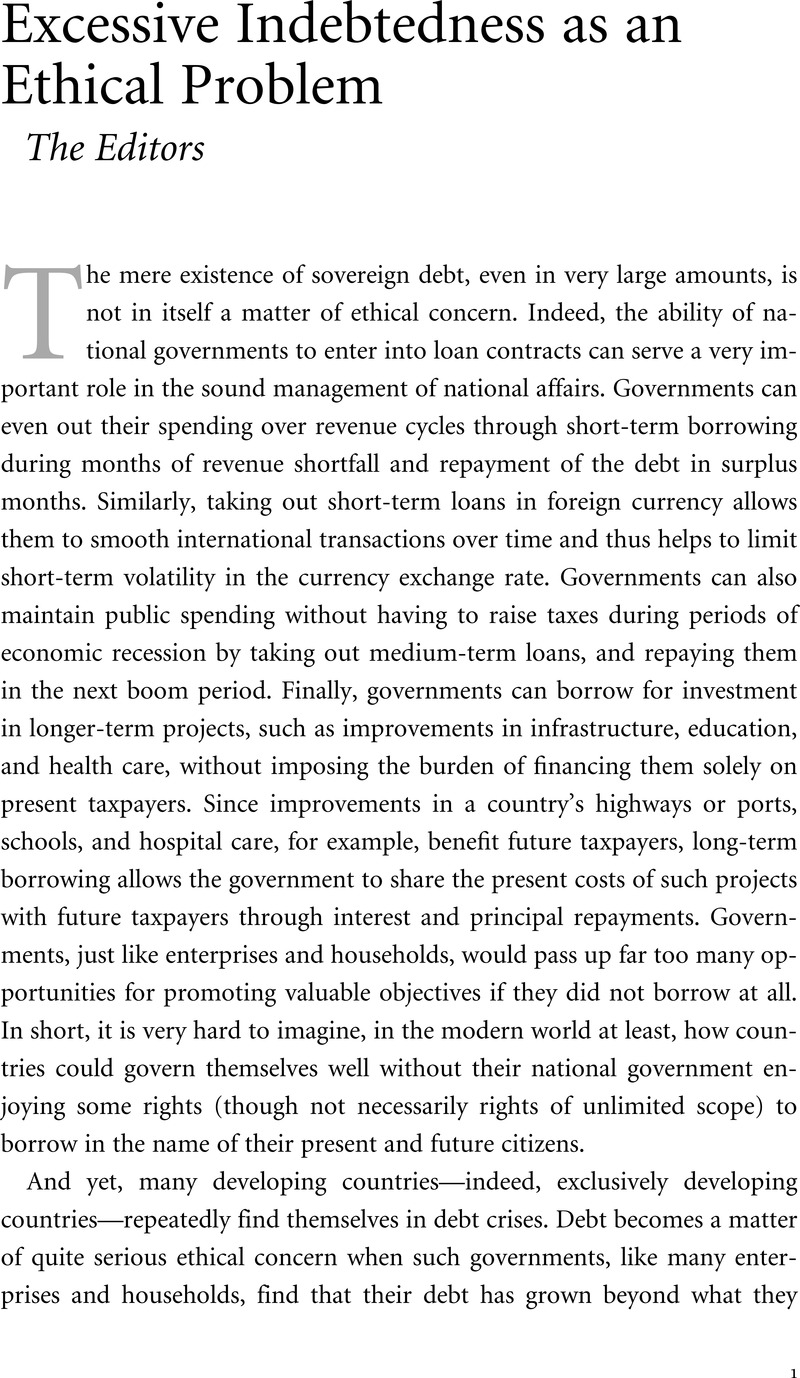No CrossRef data available.
Article contents
Excessive Indebtedness as an Ethical Problem
Published online by Cambridge University Press: 25 March 2011
Abstract

- Type
- Part I: The Matter of Fairness in Developing Country Debt
- Information
- Ethics & International Affairs , Volume 21 , Issue S1: Dealing Fairly with Developing Country Debt , November 2007 , pp. 1 - 7
- Copyright
- Copyright © Carnegie Council for Ethics in International Affairs 2007
References
Notes
1 More precisely, 45.4 percent of the urban population fell below the poverty line in 2002, roughly double what it was in 1990, and 18.6 percent of the population of the major metropolitan areas was classified as “indigent, ” compared to 5.2 percent in 1990; poverty line is defined as an income level less than twice the cost of a basic food basket and “indigent” entails income less than the cost of the food basket. See Economic Commission for Latin America and the Caribbean, Statistical Yearbook for Latin America and the Caribbean, 2005 (Santiago: United Nations, 2006), table 1.6.1.
2 See Oxfam, “Debt Relief for Tanzania: An Opportunity for a Better Future, ” April 1998; available at http:\\www.oxfam.org.uk/what_we_do/issues/debt_aid/papers.htm.
3 For one account, see Noreena Hertz, The Debt Threat: How Debt Is Destroying the Developing World (New York: Harper Business, 2004).
4 IMF, World Economic Outlook, September 2006, p. 182 and n. 186.
5 See World Bank, Global Development Finance, 2006, pp. 73–74.
6 For 2006, the Brazilian government projected spending in the named categories at 18.5 percent of federal expenditures, whereas it projected interest payments at 19.1 percent of expenditures. For social expenditures, see Alcino Ferreira Câmara Neto and Matías Vernengo, “Lula's Social Policies: New Wine in Old Bottles?” Department of Economics, University of Utah, Working Paper 2006-07; available at http:\\www.econ.utah.edu/activities/papers/2006_07.pdf. For interest payments data, see IMF, “IMF Executive Board Concludes 2006 Article IV Consultation with Brazil, ” Public Information Note 06/69, June 19, 2006, at http:\\www.imf.org/external/np/sec/pn/2006/pn0669.htm.
7 Barbara Rudolph, “Enter the Brady Plan, ” Time, March 20, 1989, p. 54.
8 For the World Bank's description of the HIPC Initiative, see http:\\www.worldbank.org/hipc/about/hipcbr/hipcbr.htm.
9 See Kunibert Raffer, “Applying Chapter 9 Insolvency to International Debts: An Economically Efficient Solution with a Human Face, ” World Development 18, no. 2 (1990), pp. 301–13.
10 See Ashfaq Khalfan, Jeff King, and Bryan Thomas, “Advancing the Odious Debt Doctrine” (Montreal: Centre for International Sustainable Development Law, 2003); available at http:\\www.cisdl.org/pdf/debtentire.pdf.
11 See Stephen J. Choi and G. Mitu Gulati, “Innovation in Boilerplate Contracts: An Empirical Examination of Sovereign Bonds, ” Emory Law Journal 53 (2004), pp. 929–96.
12 Nevertheless, Christian Barry and Lydia Tomitova explore various aspects of some of the ideas presented in several of the chapters of this volume in “Fairness in Sovereign Debt, ” this volume, pp. 41–79. Also, Barry Herman has prepared a detailed synthesis of the essays prepared for this project and their possible implications for policy and advocacy. See his “Doing the Right Thing: Dealing with Developing Country Sovereign Debt, ” North Carolina Journal of International Law and Commercial Regulation 32, no. 4 (2007), pp. 773–818.




